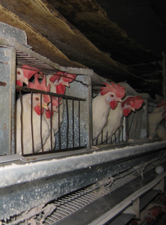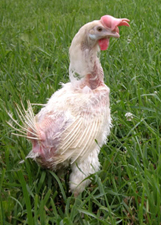
|
There are over 10 million female chickens in Florida egg farms, making Florida the 8th largest egg producing state. On egg factory farms, hens are housed in rows of bare wire cages called “battery cages.” As many as 100,000 birds may be crammed into a single windowless building; some farms in Florida confine over 1 million birds. (photo: chickens at a typical Florida egg farm) Four to six hens are crowded into each cage. They are unable to stretch their wings or even lie down comfortably. Hens have strong instincts to build a nest in which to lay her eggs, to dust-bathe and perch. None of these natural behaviors are possible on egg farms. In the cages, hens suffer from foot and leg deformities, and feather loss from constantly rubbing against the wire. In an attempt to reduce pecking and injuries— problems resulting from overcrowding— part of hens’ beaks are sometimes severed at the tip using a hot blade, without the use of anesthesia. “Debeaking” is an extremely painful but standard poultry industry practice.
Another problem inherent in egg production is the disposal of unwanted male chicks at the hatchery. Male chicks have no value to egg farmers, so they are killed as cheaply as possible; they may be thrown into trash cans to slowly suffocate, or ground up alive. The intensive confinement of hens in battery cages has been recognized as inhumane in many countries. Germany, Switzerland, Sweden and Austria have banned battery cages. The entire European Union is phasing out cages by 2012. What
About “Cage Free” or “Free Range” Eggs? Unfortunately, debeaking is allowed under these standards. At the end of a year or two, when their egg production declines, “cage free” and “free range” hens are hauled to slaughter along with battery-caged hens.
You
Can Help Click here for information on cooking without eggs. For vegan recipes and products, check out VegCooking.com. - Approach your local government leaders and ask them to consider a resolution opposing the cruelty of cage egg production and/or other factory farm abuses.
Update:
City of Tampa takes a stand against the cruel confinement of
chickens
Tampa is the fifth city in Florida to pass a resolution condemning the intensive confinement of chickens in cages. The cities of Hollywood, West Palm Beach, Winter Springs and New Port Richey have also passed resolutions opposing battery cage confinement. |
|
|
1431 N. Federal Highway • Fort Lauderdale, Florida 33304 • (954) 727-ARFF



 "Chickens
are birds. Like all other birds, chickens love to be free. Left
to their own devices, they will stay outside from dawn until
dusk foraging, socializing, dust bathing, splashing in puddles,
and perching on the low limbs of trees. They like to rest in
the sun on winter mornings and nap in the shade on summer afternoons."
—Eastern Shore Sanctuary
"Chickens
are birds. Like all other birds, chickens love to be free. Left
to their own devices, they will stay outside from dawn until
dusk foraging, socializing, dust bathing, splashing in puddles,
and perching on the low limbs of trees. They like to rest in
the sun on winter mornings and nap in the shade on summer afternoons."
—Eastern Shore Sanctuary Although
chickens can live to be over 10 years old, in egg farms they
rarely see their second birthday. When a hen is no longer producing
a sufficient number of eggs, she will be sent to slaughter.
Many never make it, and die in the cage from heat stress, disease
or injuries.
Although
chickens can live to be over 10 years old, in egg farms they
rarely see their second birthday. When a hen is no longer producing
a sufficient number of eggs, she will be sent to slaughter.
Many never make it, and die in the cage from heat stress, disease
or injuries.  The
commercial production of eggs, milk and other animal products
can never be cruelty-free. But animal-welfare campaigns, such
as efforts to end the use of battery cages, have improved the
lives of millions of animals and increased public awareness
about animals.
The
commercial production of eggs, milk and other animal products
can never be cruelty-free. But animal-welfare campaigns, such
as efforts to end the use of battery cages, have improved the
lives of millions of animals and increased public awareness
about animals.